Impact of Globalization on Nestle's Employee Recruitment and Training
VerifiedAdded on 2021/02/22
|39
|8516
|82
Report
AI Summary
This report provides an in-depth analysis of how multinational companies, specifically Nestle, improve their recruitment, selection, and training processes to meet international requirements in the context of globalization. The research explores the impact of globalization on Nestle's HR practices, examining current trends, the significance of these practices, and the challenges faced by the company. The report includes a literature review, a project management plan outlining the scope, time, cost, risk, communication, resources, and quality considerations. It also covers research methodologies, including research design, approach, sampling, data collection, and analysis. Furthermore, the report presents recommendations for improving recruitment, selection, and training at Nestle, along with a reflection on the findings. The study utilizes both primary and secondary research methods, including questionnaires and data analysis, to provide a comprehensive understanding of Nestle's HR strategies. The report concludes with a summary of the findings and a list of references.

MANAGING
SUCCESSFUL BUSINESS
PROJECT
SUCCESSFUL BUSINESS
PROJECT
Paraphrase This Document
Need a fresh take? Get an instant paraphrase of this document with our AI Paraphraser
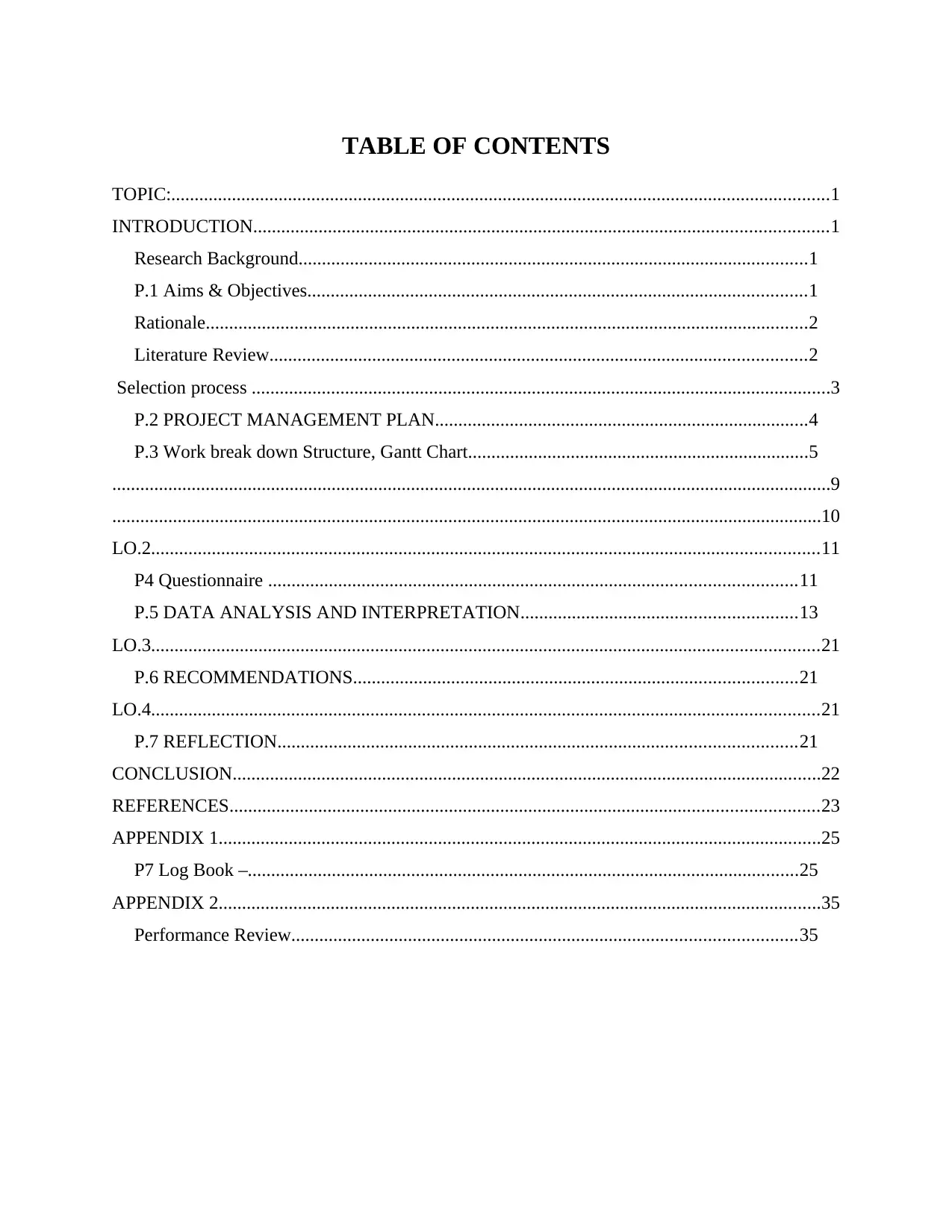
TABLE OF CONTENTS
TOPIC:.............................................................................................................................................1
INTRODUCTION...........................................................................................................................1
Research Background.............................................................................................................1
P.1 Aims & Objectives...........................................................................................................1
Rationale.................................................................................................................................2
Literature Review...................................................................................................................2
Selection process ............................................................................................................................3
P.2 PROJECT MANAGEMENT PLAN................................................................................4
P.3 Work break down Structure, Gantt Chart.........................................................................5
..........................................................................................................................................................9
........................................................................................................................................................10
LO.2...............................................................................................................................................11
P4 Questionnaire .................................................................................................................11
P.5 DATA ANALYSIS AND INTERPRETATION...........................................................13
LO.3...............................................................................................................................................21
P.6 RECOMMENDATIONS...............................................................................................21
LO.4...............................................................................................................................................21
P.7 REFLECTION...............................................................................................................21
CONCLUSION..............................................................................................................................22
REFERENCES..............................................................................................................................23
APPENDIX 1.................................................................................................................................25
P7 Log Book –......................................................................................................................25
APPENDIX 2.................................................................................................................................35
Performance Review............................................................................................................35
TOPIC:.............................................................................................................................................1
INTRODUCTION...........................................................................................................................1
Research Background.............................................................................................................1
P.1 Aims & Objectives...........................................................................................................1
Rationale.................................................................................................................................2
Literature Review...................................................................................................................2
Selection process ............................................................................................................................3
P.2 PROJECT MANAGEMENT PLAN................................................................................4
P.3 Work break down Structure, Gantt Chart.........................................................................5
..........................................................................................................................................................9
........................................................................................................................................................10
LO.2...............................................................................................................................................11
P4 Questionnaire .................................................................................................................11
P.5 DATA ANALYSIS AND INTERPRETATION...........................................................13
LO.3...............................................................................................................................................21
P.6 RECOMMENDATIONS...............................................................................................21
LO.4...............................................................................................................................................21
P.7 REFLECTION...............................................................................................................21
CONCLUSION..............................................................................................................................22
REFERENCES..............................................................................................................................23
APPENDIX 1.................................................................................................................................25
P7 Log Book –......................................................................................................................25
APPENDIX 2.................................................................................................................................35
Performance Review............................................................................................................35
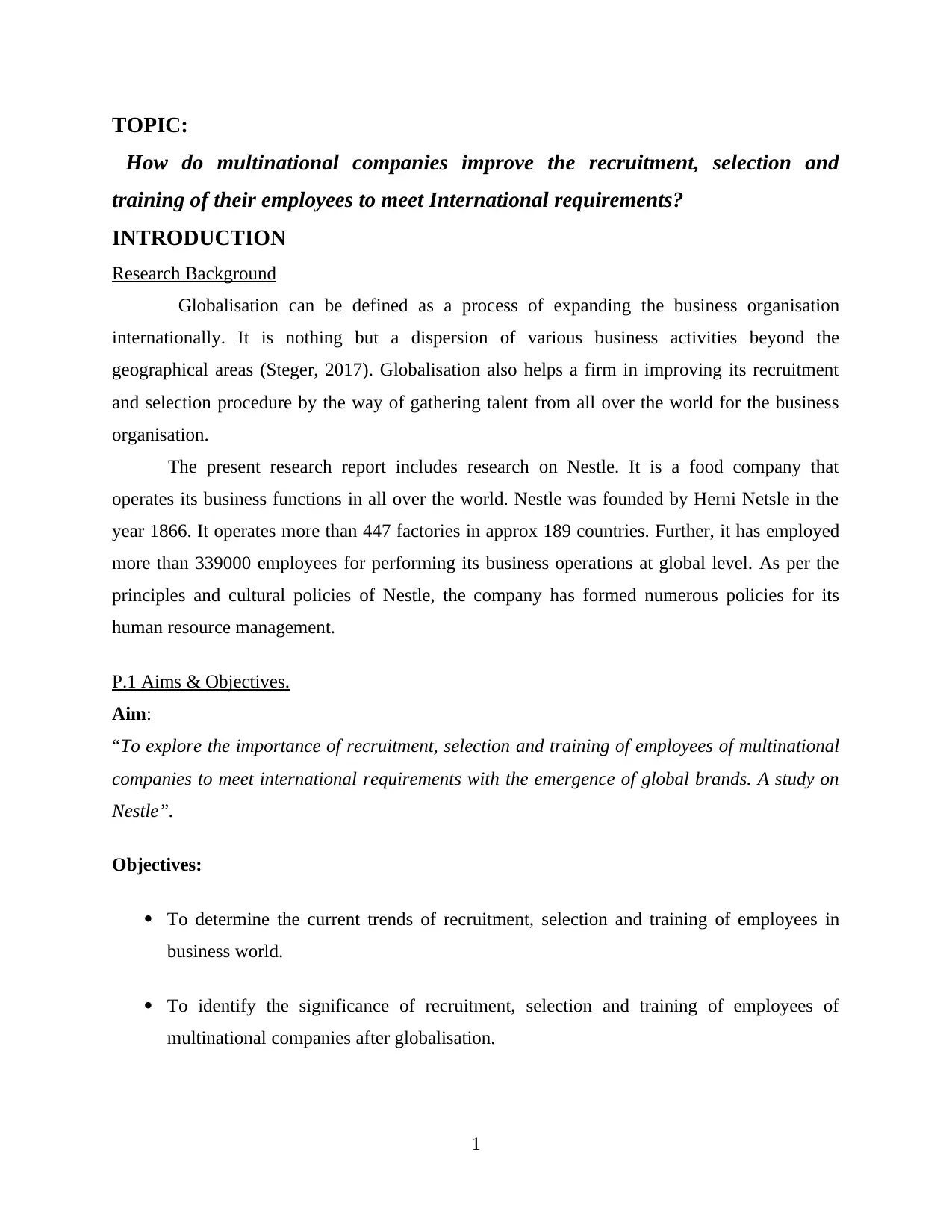
TOPIC:
How do multinational companies improve the recruitment, selection and
training of their employees to meet International requirements?
INTRODUCTION
Research Background
Globalisation can be defined as a process of expanding the business organisation
internationally. It is nothing but a dispersion of various business activities beyond the
geographical areas (Steger, 2017). Globalisation also helps a firm in improving its recruitment
and selection procedure by the way of gathering talent from all over the world for the business
organisation.
The present research report includes research on Nestle. It is a food company that
operates its business functions in all over the world. Nestle was founded by Herni Netsle in the
year 1866. It operates more than 447 factories in approx 189 countries. Further, it has employed
more than 339000 employees for performing its business operations at global level. As per the
principles and cultural policies of Nestle, the company has formed numerous policies for its
human resource management.
P.1 Aims & Objectives.
Aim:
“To explore the importance of recruitment, selection and training of employees of multinational
companies to meet international requirements with the emergence of global brands. A study on
Nestle”.
Objectives:
To determine the current trends of recruitment, selection and training of employees in
business world.
To identify the significance of recruitment, selection and training of employees of
multinational companies after globalisation.
1
How do multinational companies improve the recruitment, selection and
training of their employees to meet International requirements?
INTRODUCTION
Research Background
Globalisation can be defined as a process of expanding the business organisation
internationally. It is nothing but a dispersion of various business activities beyond the
geographical areas (Steger, 2017). Globalisation also helps a firm in improving its recruitment
and selection procedure by the way of gathering talent from all over the world for the business
organisation.
The present research report includes research on Nestle. It is a food company that
operates its business functions in all over the world. Nestle was founded by Herni Netsle in the
year 1866. It operates more than 447 factories in approx 189 countries. Further, it has employed
more than 339000 employees for performing its business operations at global level. As per the
principles and cultural policies of Nestle, the company has formed numerous policies for its
human resource management.
P.1 Aims & Objectives.
Aim:
“To explore the importance of recruitment, selection and training of employees of multinational
companies to meet international requirements with the emergence of global brands. A study on
Nestle”.
Objectives:
To determine the current trends of recruitment, selection and training of employees in
business world.
To identify the significance of recruitment, selection and training of employees of
multinational companies after globalisation.
1
⊘ This is a preview!⊘
Do you want full access?
Subscribe today to unlock all pages.

Trusted by 1+ million students worldwide
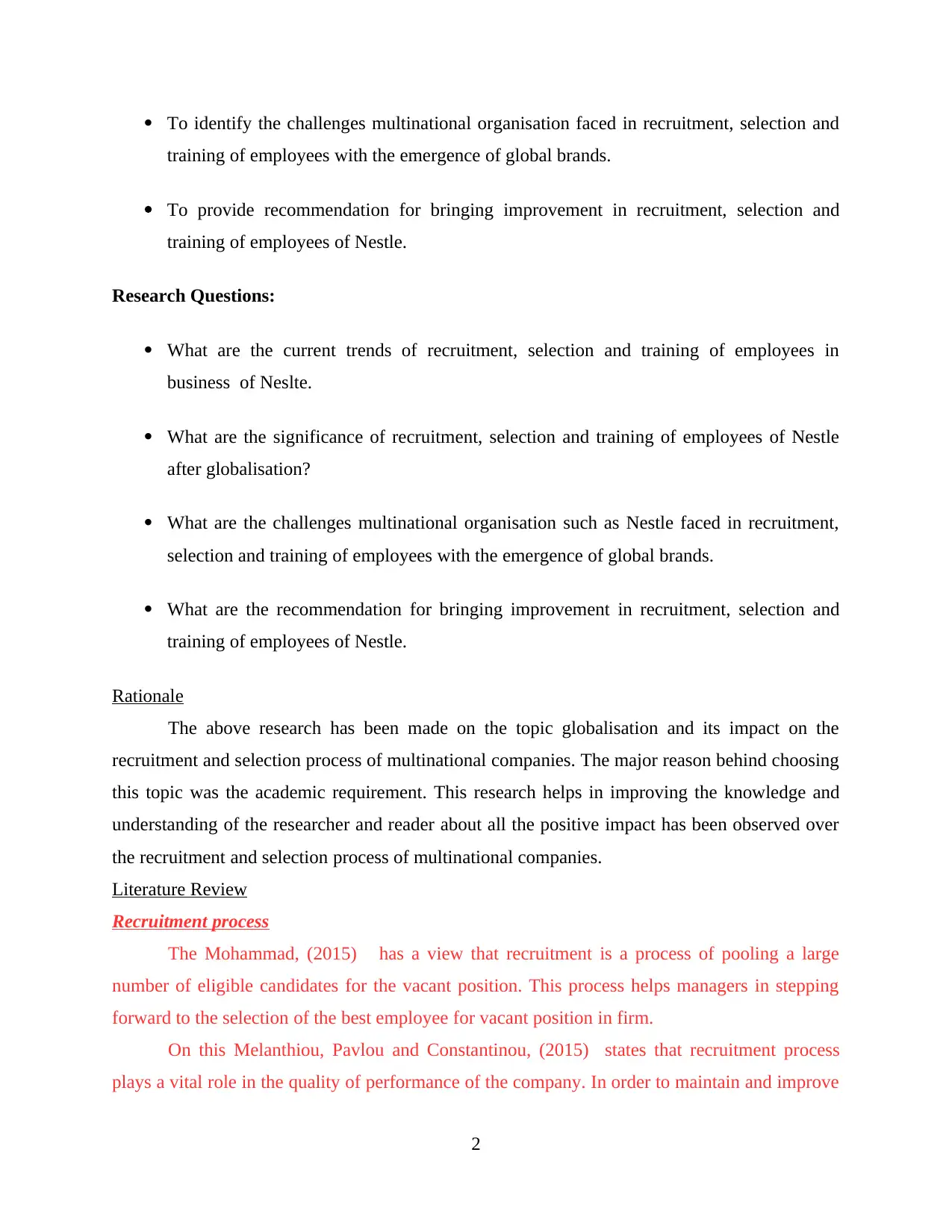
To identify the challenges multinational organisation faced in recruitment, selection and
training of employees with the emergence of global brands.
To provide recommendation for bringing improvement in recruitment, selection and
training of employees of Nestle.
Research Questions:
What are the current trends of recruitment, selection and training of employees in
business of Neslte.
What are the significance of recruitment, selection and training of employees of Nestle
after globalisation?
What are the challenges multinational organisation such as Nestle faced in recruitment,
selection and training of employees with the emergence of global brands.
What are the recommendation for bringing improvement in recruitment, selection and
training of employees of Nestle.
Rationale
The above research has been made on the topic globalisation and its impact on the
recruitment and selection process of multinational companies. The major reason behind choosing
this topic was the academic requirement. This research helps in improving the knowledge and
understanding of the researcher and reader about all the positive impact has been observed over
the recruitment and selection process of multinational companies.
Literature Review
Recruitment process
The Mohammad, (2015) has a view that recruitment is a process of pooling a large
number of eligible candidates for the vacant position. This process helps managers in stepping
forward to the selection of the best employee for vacant position in firm.
On this Melanthiou, Pavlou and Constantinou, (2015) states that recruitment process
plays a vital role in the quality of performance of the company. In order to maintain and improve
2
training of employees with the emergence of global brands.
To provide recommendation for bringing improvement in recruitment, selection and
training of employees of Nestle.
Research Questions:
What are the current trends of recruitment, selection and training of employees in
business of Neslte.
What are the significance of recruitment, selection and training of employees of Nestle
after globalisation?
What are the challenges multinational organisation such as Nestle faced in recruitment,
selection and training of employees with the emergence of global brands.
What are the recommendation for bringing improvement in recruitment, selection and
training of employees of Nestle.
Rationale
The above research has been made on the topic globalisation and its impact on the
recruitment and selection process of multinational companies. The major reason behind choosing
this topic was the academic requirement. This research helps in improving the knowledge and
understanding of the researcher and reader about all the positive impact has been observed over
the recruitment and selection process of multinational companies.
Literature Review
Recruitment process
The Mohammad, (2015) has a view that recruitment is a process of pooling a large
number of eligible candidates for the vacant position. This process helps managers in stepping
forward to the selection of the best employee for vacant position in firm.
On this Melanthiou, Pavlou and Constantinou, (2015) states that recruitment process
plays a vital role in the quality of performance of the company. In order to maintain and improve
2
Paraphrase This Document
Need a fresh take? Get an instant paraphrase of this document with our AI Paraphraser
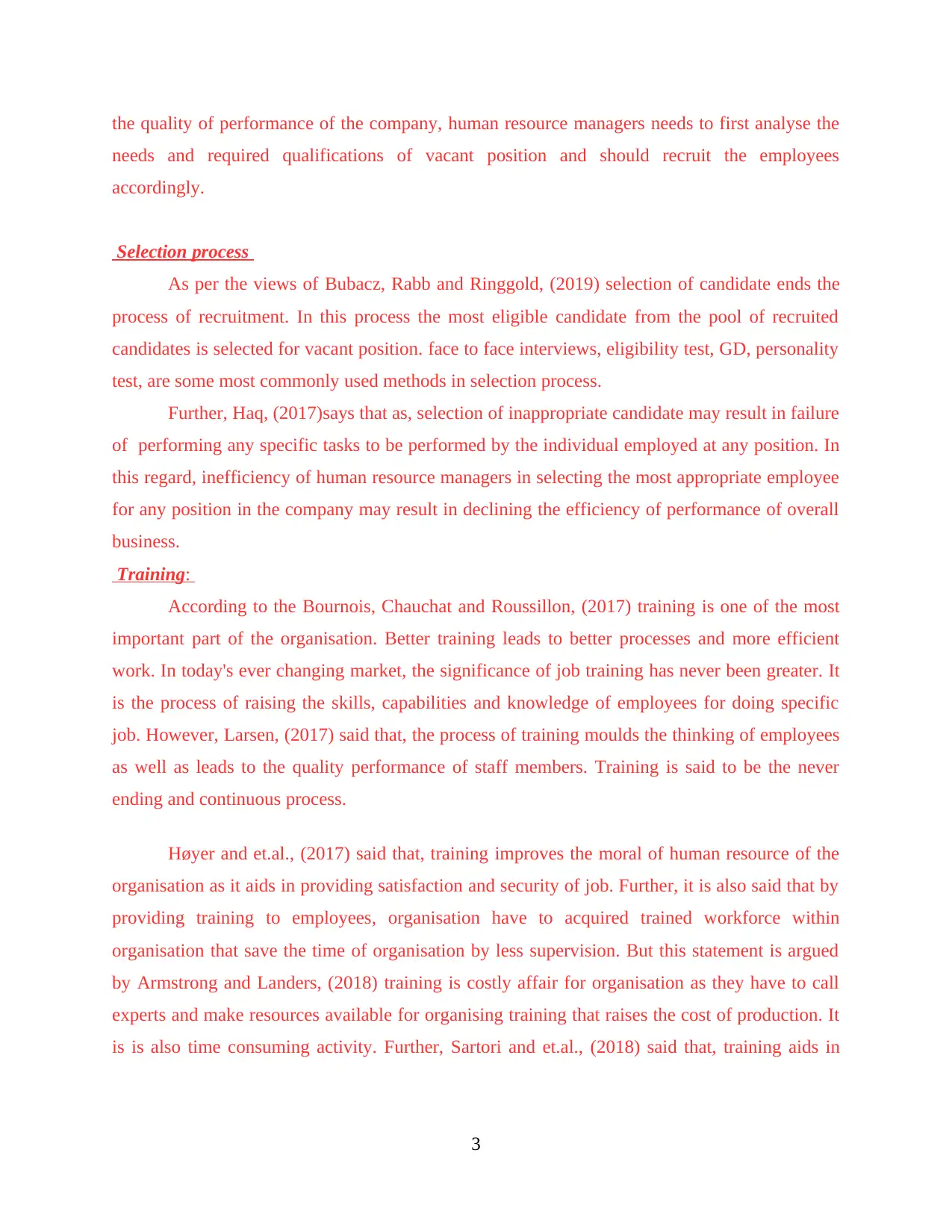
the quality of performance of the company, human resource managers needs to first analyse the
needs and required qualifications of vacant position and should recruit the employees
accordingly.
Selection process
As per the views of Bubacz, Rabb and Ringgold, (2019) selection of candidate ends the
process of recruitment. In this process the most eligible candidate from the pool of recruited
candidates is selected for vacant position. face to face interviews, eligibility test, GD, personality
test, are some most commonly used methods in selection process.
Further, Haq, (2017)says that as, selection of inappropriate candidate may result in failure
of performing any specific tasks to be performed by the individual employed at any position. In
this regard, inefficiency of human resource managers in selecting the most appropriate employee
for any position in the company may result in declining the efficiency of performance of overall
business.
Training:
According to the Bournois, Chauchat and Roussillon, (2017) training is one of the most
important part of the organisation. Better training leads to better processes and more efficient
work. In today's ever changing market, the significance of job training has never been greater. It
is the process of raising the skills, capabilities and knowledge of employees for doing specific
job. However, Larsen, (2017) said that, the process of training moulds the thinking of employees
as well as leads to the quality performance of staff members. Training is said to be the never
ending and continuous process.
Høyer and et.al., (2017) said that, training improves the moral of human resource of the
organisation as it aids in providing satisfaction and security of job. Further, it is also said that by
providing training to employees, organisation have to acquired trained workforce within
organisation that save the time of organisation by less supervision. But this statement is argued
by Armstrong and Landers, (2018) training is costly affair for organisation as they have to call
experts and make resources available for organising training that raises the cost of production. It
is is also time consuming activity. Further, Sartori and et.al., (2018) said that, training aids in
3
needs and required qualifications of vacant position and should recruit the employees
accordingly.
Selection process
As per the views of Bubacz, Rabb and Ringgold, (2019) selection of candidate ends the
process of recruitment. In this process the most eligible candidate from the pool of recruited
candidates is selected for vacant position. face to face interviews, eligibility test, GD, personality
test, are some most commonly used methods in selection process.
Further, Haq, (2017)says that as, selection of inappropriate candidate may result in failure
of performing any specific tasks to be performed by the individual employed at any position. In
this regard, inefficiency of human resource managers in selecting the most appropriate employee
for any position in the company may result in declining the efficiency of performance of overall
business.
Training:
According to the Bournois, Chauchat and Roussillon, (2017) training is one of the most
important part of the organisation. Better training leads to better processes and more efficient
work. In today's ever changing market, the significance of job training has never been greater. It
is the process of raising the skills, capabilities and knowledge of employees for doing specific
job. However, Larsen, (2017) said that, the process of training moulds the thinking of employees
as well as leads to the quality performance of staff members. Training is said to be the never
ending and continuous process.
Høyer and et.al., (2017) said that, training improves the moral of human resource of the
organisation as it aids in providing satisfaction and security of job. Further, it is also said that by
providing training to employees, organisation have to acquired trained workforce within
organisation that save the time of organisation by less supervision. But this statement is argued
by Armstrong and Landers, (2018) training is costly affair for organisation as they have to call
experts and make resources available for organising training that raises the cost of production. It
is is also time consuming activity. Further, Sartori and et.al., (2018) said that, training aids in
3
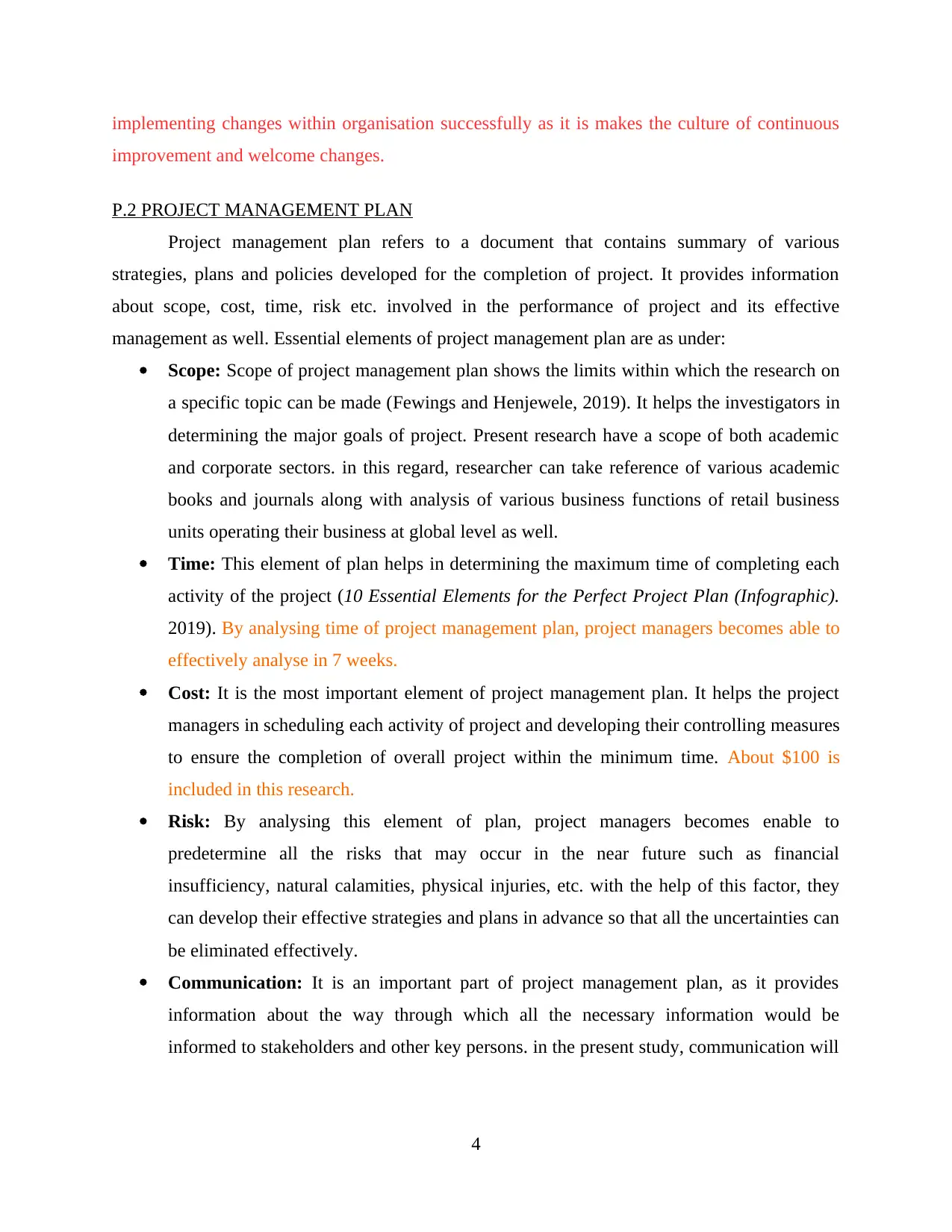
implementing changes within organisation successfully as it is makes the culture of continuous
improvement and welcome changes.
P.2 PROJECT MANAGEMENT PLAN
Project management plan refers to a document that contains summary of various
strategies, plans and policies developed for the completion of project. It provides information
about scope, cost, time, risk etc. involved in the performance of project and its effective
management as well. Essential elements of project management plan are as under:
Scope: Scope of project management plan shows the limits within which the research on
a specific topic can be made (Fewings and Henjewele, 2019). It helps the investigators in
determining the major goals of project. Present research have a scope of both academic
and corporate sectors. in this regard, researcher can take reference of various academic
books and journals along with analysis of various business functions of retail business
units operating their business at global level as well.
Time: This element of plan helps in determining the maximum time of completing each
activity of the project (10 Essential Elements for the Perfect Project Plan (Infographic).
2019). By analysing time of project management plan, project managers becomes able to
effectively analyse in 7 weeks.
Cost: It is the most important element of project management plan. It helps the project
managers in scheduling each activity of project and developing their controlling measures
to ensure the completion of overall project within the minimum time. About $100 is
included in this research.
Risk: By analysing this element of plan, project managers becomes enable to
predetermine all the risks that may occur in the near future such as financial
insufficiency, natural calamities, physical injuries, etc. with the help of this factor, they
can develop their effective strategies and plans in advance so that all the uncertainties can
be eliminated effectively.
Communication: It is an important part of project management plan, as it provides
information about the way through which all the necessary information would be
informed to stakeholders and other key persons. in the present study, communication will
4
improvement and welcome changes.
P.2 PROJECT MANAGEMENT PLAN
Project management plan refers to a document that contains summary of various
strategies, plans and policies developed for the completion of project. It provides information
about scope, cost, time, risk etc. involved in the performance of project and its effective
management as well. Essential elements of project management plan are as under:
Scope: Scope of project management plan shows the limits within which the research on
a specific topic can be made (Fewings and Henjewele, 2019). It helps the investigators in
determining the major goals of project. Present research have a scope of both academic
and corporate sectors. in this regard, researcher can take reference of various academic
books and journals along with analysis of various business functions of retail business
units operating their business at global level as well.
Time: This element of plan helps in determining the maximum time of completing each
activity of the project (10 Essential Elements for the Perfect Project Plan (Infographic).
2019). By analysing time of project management plan, project managers becomes able to
effectively analyse in 7 weeks.
Cost: It is the most important element of project management plan. It helps the project
managers in scheduling each activity of project and developing their controlling measures
to ensure the completion of overall project within the minimum time. About $100 is
included in this research.
Risk: By analysing this element of plan, project managers becomes enable to
predetermine all the risks that may occur in the near future such as financial
insufficiency, natural calamities, physical injuries, etc. with the help of this factor, they
can develop their effective strategies and plans in advance so that all the uncertainties can
be eliminated effectively.
Communication: It is an important part of project management plan, as it provides
information about the way through which all the necessary information would be
informed to stakeholders and other key persons. in the present study, communication will
4
⊘ This is a preview!⊘
Do you want full access?
Subscribe today to unlock all pages.

Trusted by 1+ million students worldwide
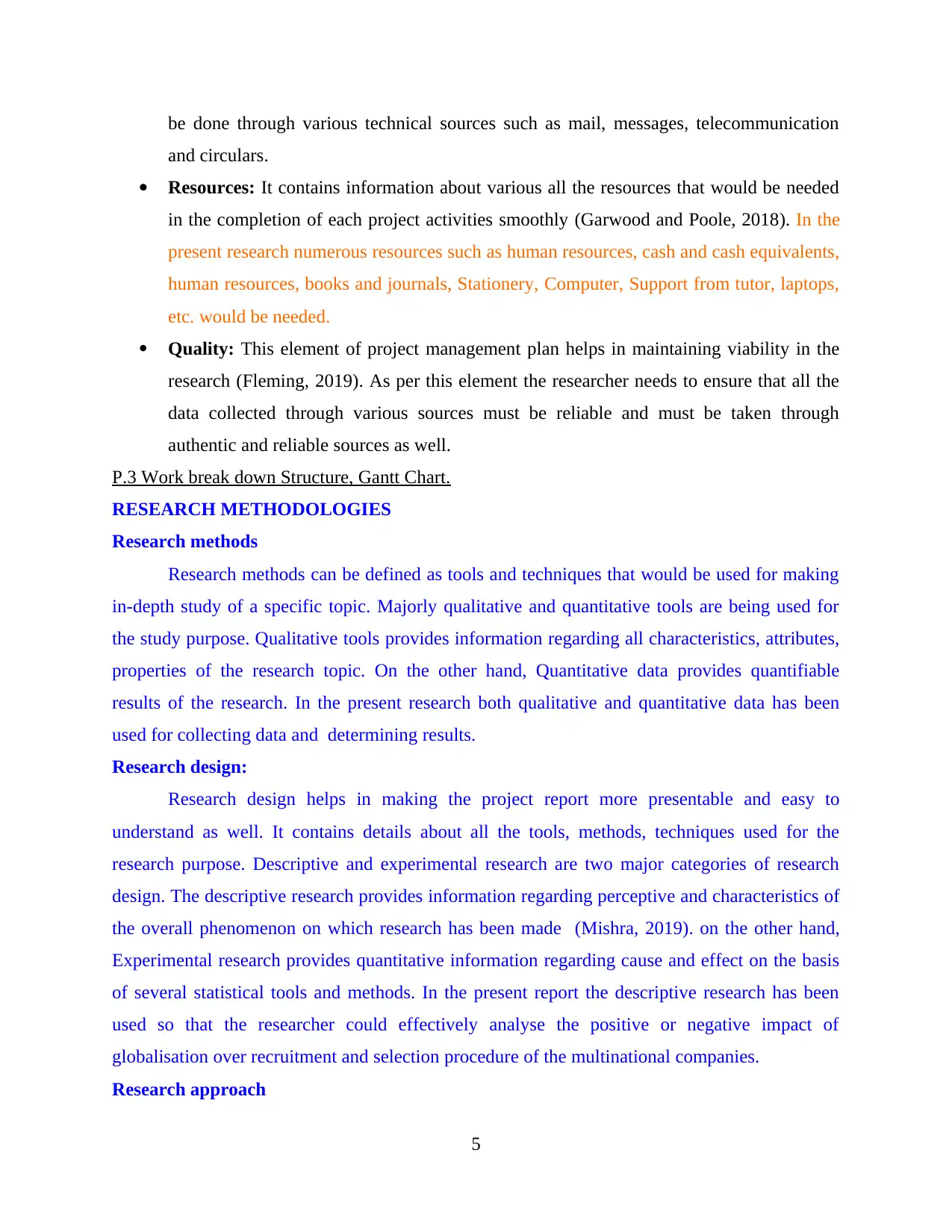
be done through various technical sources such as mail, messages, telecommunication
and circulars.
Resources: It contains information about various all the resources that would be needed
in the completion of each project activities smoothly (Garwood and Poole, 2018). In the
present research numerous resources such as human resources, cash and cash equivalents,
human resources, books and journals, Stationery, Computer, Support from tutor, laptops,
etc. would be needed.
Quality: This element of project management plan helps in maintaining viability in the
research (Fleming, 2019). As per this element the researcher needs to ensure that all the
data collected through various sources must be reliable and must be taken through
authentic and reliable sources as well.
P.3 Work break down Structure, Gantt Chart.
RESEARCH METHODOLOGIES
Research methods
Research methods can be defined as tools and techniques that would be used for making
in-depth study of a specific topic. Majorly qualitative and quantitative tools are being used for
the study purpose. Qualitative tools provides information regarding all characteristics, attributes,
properties of the research topic. On the other hand, Quantitative data provides quantifiable
results of the research. In the present research both qualitative and quantitative data has been
used for collecting data and determining results.
Research design:
Research design helps in making the project report more presentable and easy to
understand as well. It contains details about all the tools, methods, techniques used for the
research purpose. Descriptive and experimental research are two major categories of research
design. The descriptive research provides information regarding perceptive and characteristics of
the overall phenomenon on which research has been made (Mishra, 2019). on the other hand,
Experimental research provides quantitative information regarding cause and effect on the basis
of several statistical tools and methods. In the present report the descriptive research has been
used so that the researcher could effectively analyse the positive or negative impact of
globalisation over recruitment and selection procedure of the multinational companies.
Research approach
5
and circulars.
Resources: It contains information about various all the resources that would be needed
in the completion of each project activities smoothly (Garwood and Poole, 2018). In the
present research numerous resources such as human resources, cash and cash equivalents,
human resources, books and journals, Stationery, Computer, Support from tutor, laptops,
etc. would be needed.
Quality: This element of project management plan helps in maintaining viability in the
research (Fleming, 2019). As per this element the researcher needs to ensure that all the
data collected through various sources must be reliable and must be taken through
authentic and reliable sources as well.
P.3 Work break down Structure, Gantt Chart.
RESEARCH METHODOLOGIES
Research methods
Research methods can be defined as tools and techniques that would be used for making
in-depth study of a specific topic. Majorly qualitative and quantitative tools are being used for
the study purpose. Qualitative tools provides information regarding all characteristics, attributes,
properties of the research topic. On the other hand, Quantitative data provides quantifiable
results of the research. In the present research both qualitative and quantitative data has been
used for collecting data and determining results.
Research design:
Research design helps in making the project report more presentable and easy to
understand as well. It contains details about all the tools, methods, techniques used for the
research purpose. Descriptive and experimental research are two major categories of research
design. The descriptive research provides information regarding perceptive and characteristics of
the overall phenomenon on which research has been made (Mishra, 2019). on the other hand,
Experimental research provides quantitative information regarding cause and effect on the basis
of several statistical tools and methods. In the present report the descriptive research has been
used so that the researcher could effectively analyse the positive or negative impact of
globalisation over recruitment and selection procedure of the multinational companies.
Research approach
5
Paraphrase This Document
Need a fresh take? Get an instant paraphrase of this document with our AI Paraphraser
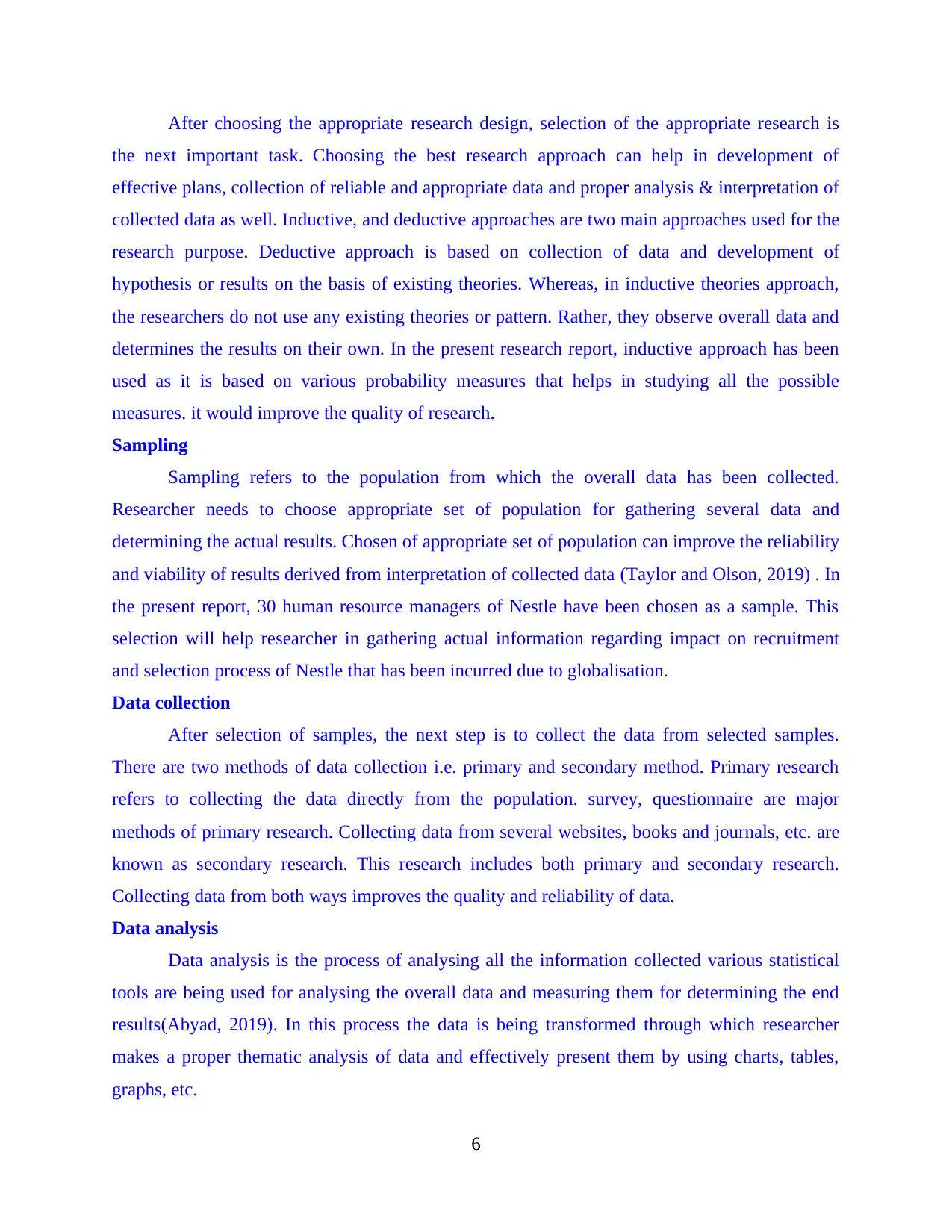
After choosing the appropriate research design, selection of the appropriate research is
the next important task. Choosing the best research approach can help in development of
effective plans, collection of reliable and appropriate data and proper analysis & interpretation of
collected data as well. Inductive, and deductive approaches are two main approaches used for the
research purpose. Deductive approach is based on collection of data and development of
hypothesis or results on the basis of existing theories. Whereas, in inductive theories approach,
the researchers do not use any existing theories or pattern. Rather, they observe overall data and
determines the results on their own. In the present research report, inductive approach has been
used as it is based on various probability measures that helps in studying all the possible
measures. it would improve the quality of research.
Sampling
Sampling refers to the population from which the overall data has been collected.
Researcher needs to choose appropriate set of population for gathering several data and
determining the actual results. Chosen of appropriate set of population can improve the reliability
and viability of results derived from interpretation of collected data (Taylor and Olson, 2019) . In
the present report, 30 human resource managers of Nestle have been chosen as a sample. This
selection will help researcher in gathering actual information regarding impact on recruitment
and selection process of Nestle that has been incurred due to globalisation.
Data collection
After selection of samples, the next step is to collect the data from selected samples.
There are two methods of data collection i.e. primary and secondary method. Primary research
refers to collecting the data directly from the population. survey, questionnaire are major
methods of primary research. Collecting data from several websites, books and journals, etc. are
known as secondary research. This research includes both primary and secondary research.
Collecting data from both ways improves the quality and reliability of data.
Data analysis
Data analysis is the process of analysing all the information collected various statistical
tools are being used for analysing the overall data and measuring them for determining the end
results(Abyad, 2019). In this process the data is being transformed through which researcher
makes a proper thematic analysis of data and effectively present them by using charts, tables,
graphs, etc.
6
the next important task. Choosing the best research approach can help in development of
effective plans, collection of reliable and appropriate data and proper analysis & interpretation of
collected data as well. Inductive, and deductive approaches are two main approaches used for the
research purpose. Deductive approach is based on collection of data and development of
hypothesis or results on the basis of existing theories. Whereas, in inductive theories approach,
the researchers do not use any existing theories or pattern. Rather, they observe overall data and
determines the results on their own. In the present research report, inductive approach has been
used as it is based on various probability measures that helps in studying all the possible
measures. it would improve the quality of research.
Sampling
Sampling refers to the population from which the overall data has been collected.
Researcher needs to choose appropriate set of population for gathering several data and
determining the actual results. Chosen of appropriate set of population can improve the reliability
and viability of results derived from interpretation of collected data (Taylor and Olson, 2019) . In
the present report, 30 human resource managers of Nestle have been chosen as a sample. This
selection will help researcher in gathering actual information regarding impact on recruitment
and selection process of Nestle that has been incurred due to globalisation.
Data collection
After selection of samples, the next step is to collect the data from selected samples.
There are two methods of data collection i.e. primary and secondary method. Primary research
refers to collecting the data directly from the population. survey, questionnaire are major
methods of primary research. Collecting data from several websites, books and journals, etc. are
known as secondary research. This research includes both primary and secondary research.
Collecting data from both ways improves the quality and reliability of data.
Data analysis
Data analysis is the process of analysing all the information collected various statistical
tools are being used for analysing the overall data and measuring them for determining the end
results(Abyad, 2019). In this process the data is being transformed through which researcher
makes a proper thematic analysis of data and effectively present them by using charts, tables,
graphs, etc.
6
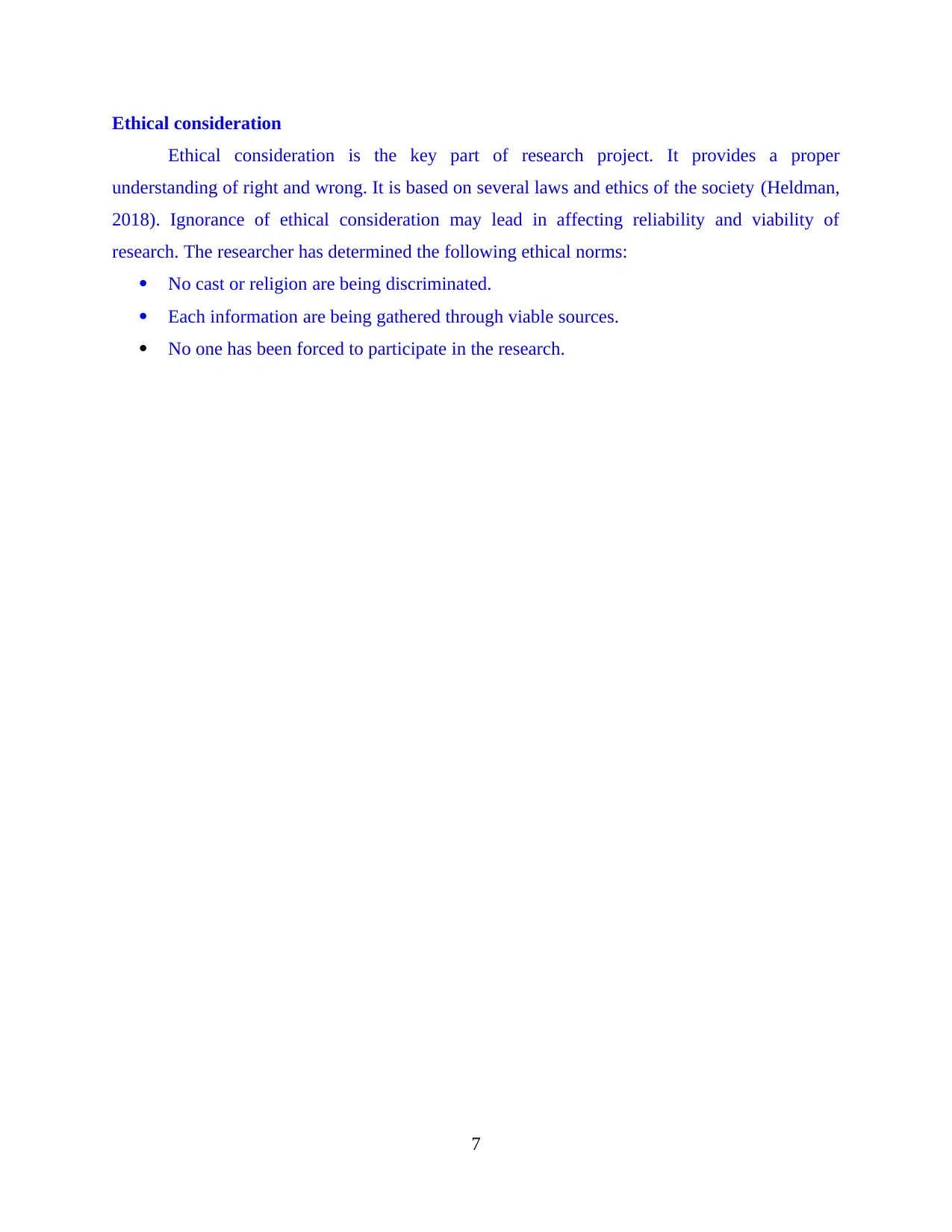
Ethical consideration
Ethical consideration is the key part of research project. It provides a proper
understanding of right and wrong. It is based on several laws and ethics of the society (Heldman,
2018). Ignorance of ethical consideration may lead in affecting reliability and viability of
research. The researcher has determined the following ethical norms:
No cast or religion are being discriminated.
Each information are being gathered through viable sources.
No one has been forced to participate in the research.
7
Ethical consideration is the key part of research project. It provides a proper
understanding of right and wrong. It is based on several laws and ethics of the society (Heldman,
2018). Ignorance of ethical consideration may lead in affecting reliability and viability of
research. The researcher has determined the following ethical norms:
No cast or religion are being discriminated.
Each information are being gathered through viable sources.
No one has been forced to participate in the research.
7
⊘ This is a preview!⊘
Do you want full access?
Subscribe today to unlock all pages.

Trusted by 1+ million students worldwide
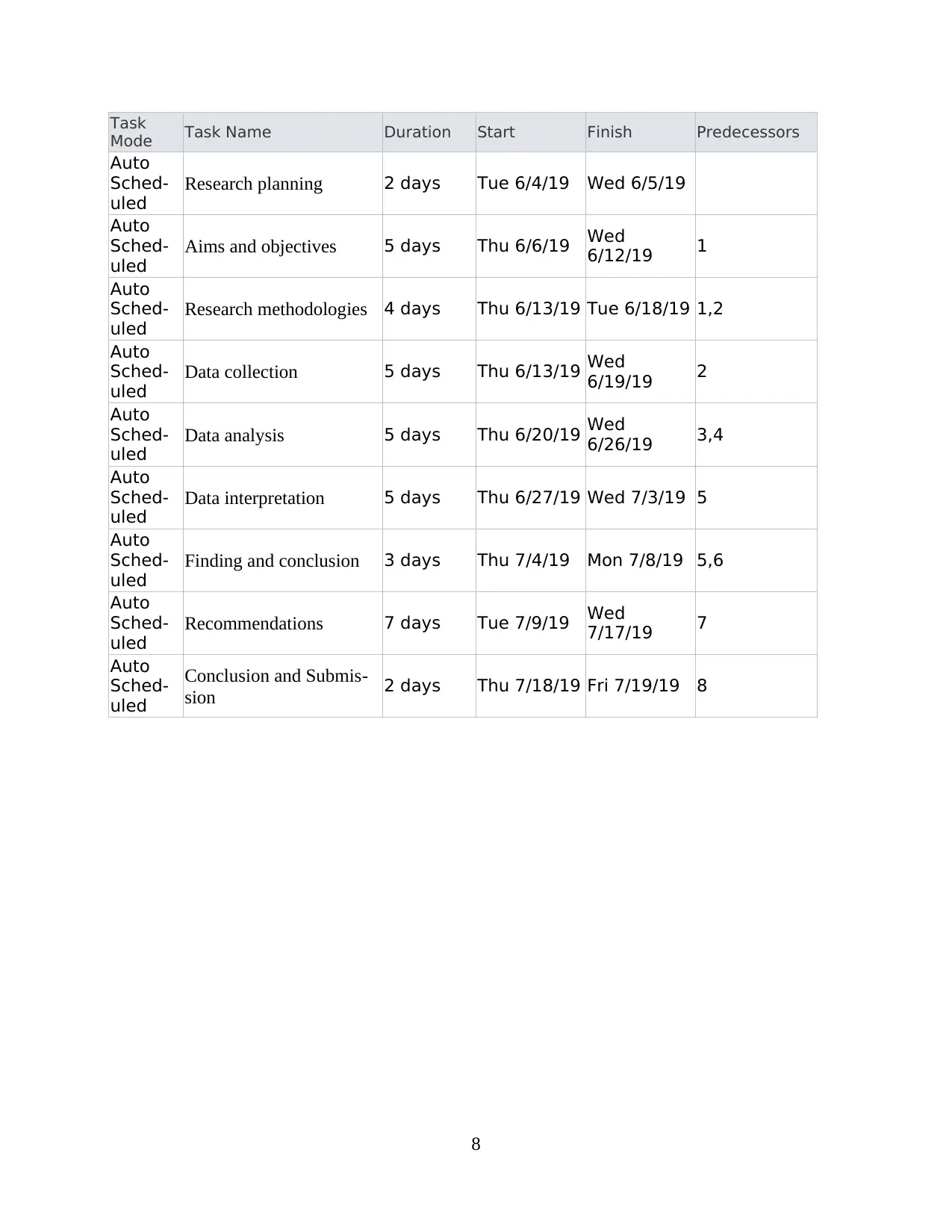
Task
Mode Task Name Duration Start Finish Predecessors
Auto
Sched-
uled
Research planning 2 days Tue 6/4/19 Wed 6/5/19
Auto
Sched-
uled
Aims and objectives 5 days Thu 6/6/19 Wed
6/12/19 1
Auto
Sched-
uled
Research methodologies 4 days Thu 6/13/19 Tue 6/18/19 1,2
Auto
Sched-
uled
Data collection 5 days Thu 6/13/19 Wed
6/19/19 2
Auto
Sched-
uled
Data analysis 5 days Thu 6/20/19 Wed
6/26/19 3,4
Auto
Sched-
uled
Data interpretation 5 days Thu 6/27/19 Wed 7/3/19 5
Auto
Sched-
uled
Finding and conclusion 3 days Thu 7/4/19 Mon 7/8/19 5,6
Auto
Sched-
uled
Recommendations 7 days Tue 7/9/19 Wed
7/17/19 7
Auto
Sched-
uled
Conclusion and Submis-
sion 2 days Thu 7/18/19 Fri 7/19/19 8
8
Mode Task Name Duration Start Finish Predecessors
Auto
Sched-
uled
Research planning 2 days Tue 6/4/19 Wed 6/5/19
Auto
Sched-
uled
Aims and objectives 5 days Thu 6/6/19 Wed
6/12/19 1
Auto
Sched-
uled
Research methodologies 4 days Thu 6/13/19 Tue 6/18/19 1,2
Auto
Sched-
uled
Data collection 5 days Thu 6/13/19 Wed
6/19/19 2
Auto
Sched-
uled
Data analysis 5 days Thu 6/20/19 Wed
6/26/19 3,4
Auto
Sched-
uled
Data interpretation 5 days Thu 6/27/19 Wed 7/3/19 5
Auto
Sched-
uled
Finding and conclusion 3 days Thu 7/4/19 Mon 7/8/19 5,6
Auto
Sched-
uled
Recommendations 7 days Tue 7/9/19 Wed
7/17/19 7
Auto
Sched-
uled
Conclusion and Submis-
sion 2 days Thu 7/18/19 Fri 7/19/19 8
8
Paraphrase This Document
Need a fresh take? Get an instant paraphrase of this document with our AI Paraphraser
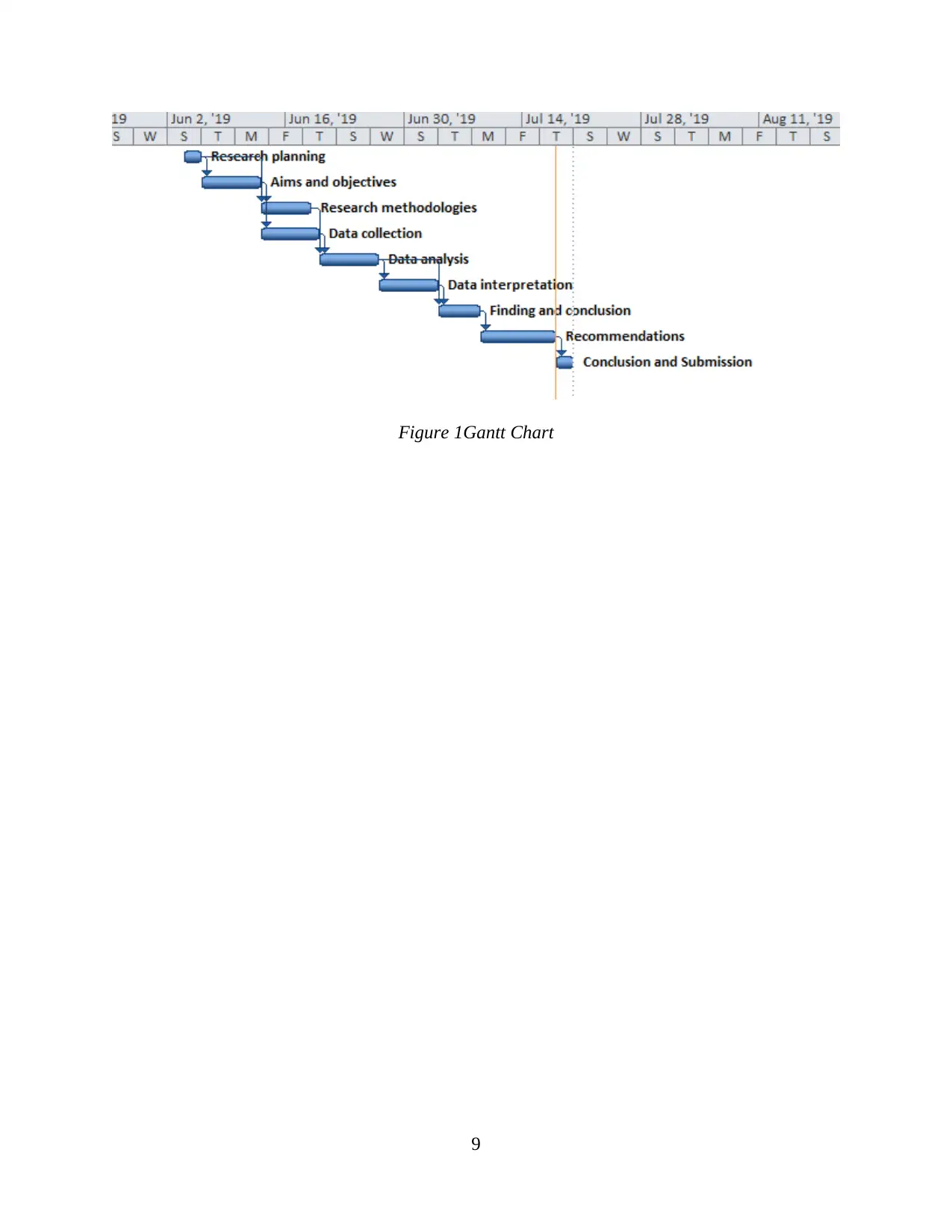
Figure 1Gantt Chart
9
9
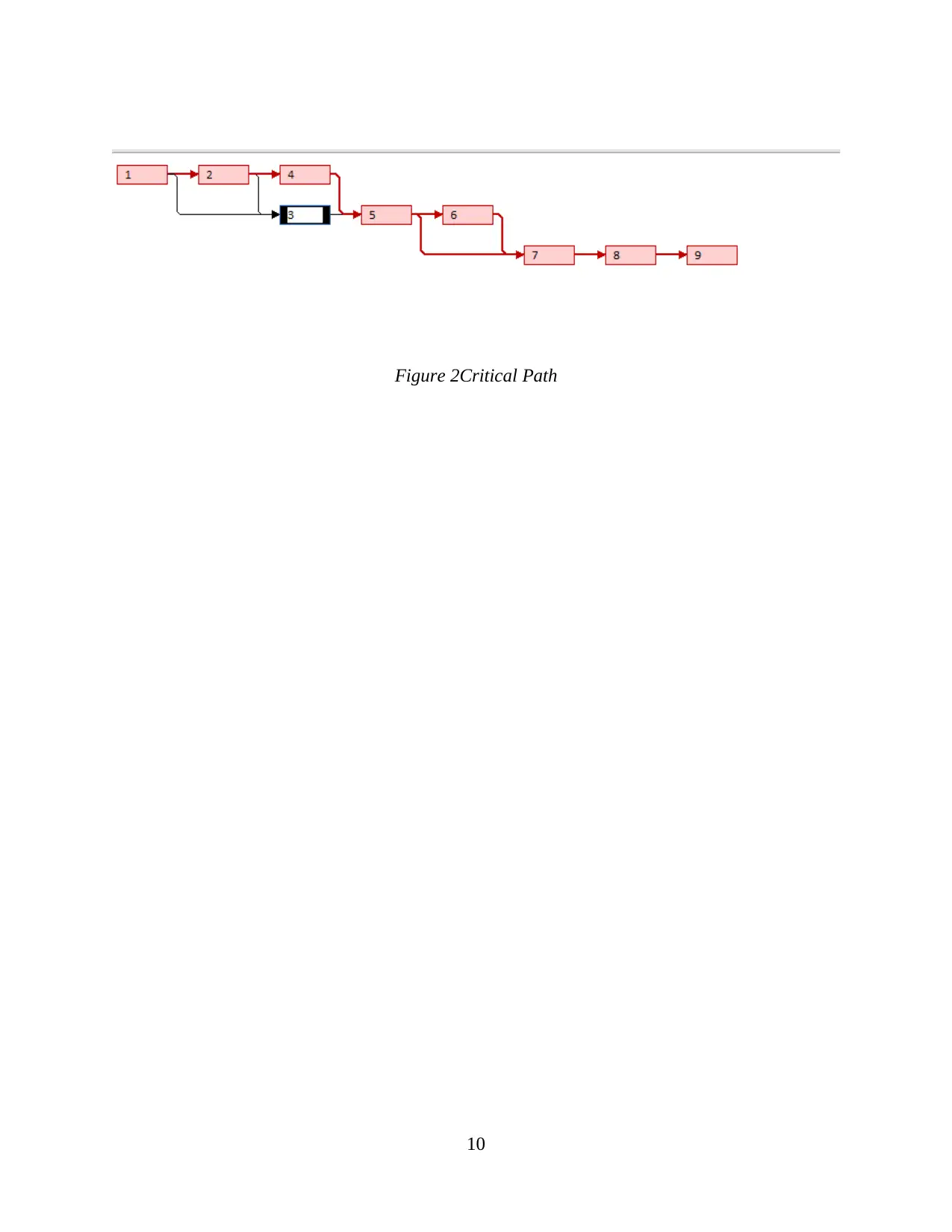
Figure 2Critical Path
10
10
⊘ This is a preview!⊘
Do you want full access?
Subscribe today to unlock all pages.

Trusted by 1+ million students worldwide
1 out of 39
Related Documents
Your All-in-One AI-Powered Toolkit for Academic Success.
+13062052269
info@desklib.com
Available 24*7 on WhatsApp / Email
![[object Object]](/_next/static/media/star-bottom.7253800d.svg)
Unlock your academic potential
Copyright © 2020–2025 A2Z Services. All Rights Reserved. Developed and managed by ZUCOL.





